Speech Implications for the Australian Economy of Strong Growth in Asia

Christopher Kent[*]
Assistant Governor (Economic)
Speech to the Structural Change and the Rise of Asia Conference
Canberra –
1. Introduction
Strong economic growth in the Asian region, particularly in China, over the past decade or more has had important macroeconomic and structural effects on the Australian economy. Most obvious has been the rise in the terms of trade to historically high levels (Figure 1), a resource investment boom, the appreciation of the exchange rate, and the reallocation of productive factors, with employment growing strongly in resource and resource-related activities and declining in a number of non-resource industries.
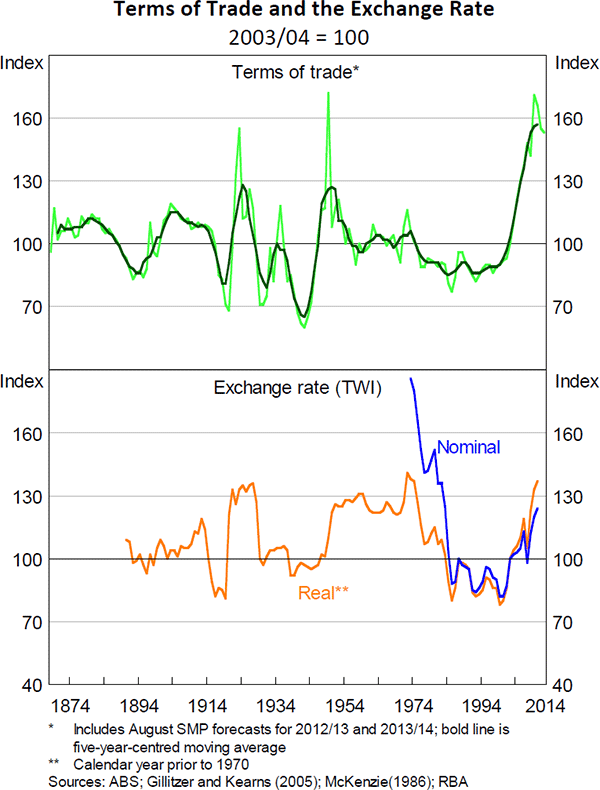
Growth in Asia is providing many benefits for the Australian economy. The commodity-intensive nature of this growth has pushed commodity prices to a high level, which is supporting significant investment in the productive capacity of the Australian resource sector and is expected to continue to support production and export of resources, as well as employment, incomes, tax revenues and wealth. And the appreciation of the exchange rate has lowered the cost of many imported goods for Australian consumers. While not all parts of the economy have benefited equally, for the economy as a whole the process of adjustment has proceeded much more smoothly than has been the case in previous resource booms; over the past seven years, growth has generally never been too far from trend, inflation within the target, or not too far from it and not for very long, and unemployment has been relatively low (Figure 2). This is perhaps all the more notable given the difficult circumstances internationally over recent years. In part this reflected the relative strength of the Chinese economy through 2009 and 2010 that benefited Asia and pushed Australia's terms of trade to new highs after they dipped during the height of the global financial crisis.
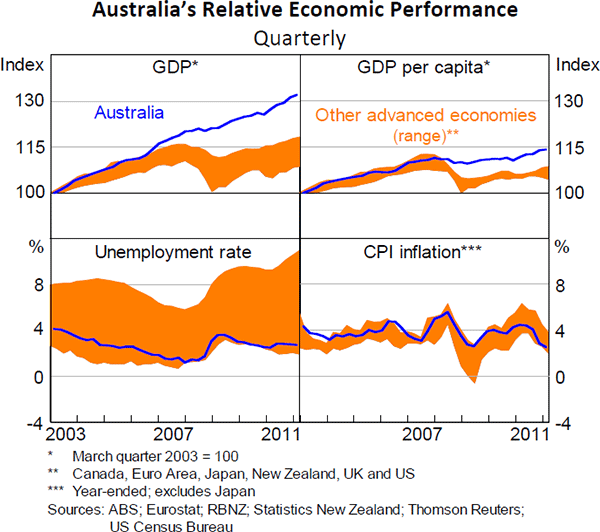
The relatively smooth adjustment of the economy overall through this boom in the terms of trade, at least to date, has certainly not been the norm in previous booms in commodity prices. A key aspect of the good performance of the macroeconomy through the current boom has been the flexibility of the exchange rate regime, with the high nominal exchange rate acting as a timely mechanism facilitating the reallocation of productive factors across industries. Of course, this process is not a painless one. It entails significant pressures on many trade-exposed industries that have not benefited from higher product prices but have faced higher wages (at least in foreign currency terms) and a softening in demand.
As well as promoting the reallocation of productive resources across the economy, the high exchange rate is one of the means by which all Australian consumers have been able to benefit from high commodity prices, by directly increasing their purchasing power over imports. Indeed, the purchasing power of the average wage has risen in all major industries since the terms of trade began to rise in 2003/04, despite upward pressure on the prices of non-tradable goods and services during the boom due to competition for domestic factors of production.[1] For some industries, such as mining, construction and professional services, the real (consumer) wage has grown quite strongly, while growth in real wages has been more subdued, yet still positive, in rental, hiring & real estate, retail and manufacturing. Growth in real household disposable income per capita has been stronger than growth in real wages, since part of the higher tax revenue from the stronger profits in the resource sector has been redistributed to households through income tax cuts and transfers.
Another feature of the current terms of trade boom is the greater extent of foreign ownership in the resource sector, with some estimates suggesting that foreign ownership is around four-fifths (Connolly and Orsmond 2011). In addition, the imported content of the current boom in resource investment has been higher than in previous booms. Both of these factors mean that the expansionary effect of the terms of trade boom is less than is implied by the extent of investment and profits in the resource sector.
The adjustment process through the current episode has also been helped by inflation expectations remaining well anchored, combined with greater flexibility in the labour market, relative to earlier booms in commodity prices. The combination of the high exchange rate, a record of low and stable inflation and a relatively flexible labour market means that while demand for labour, and the growth of wages, has been higher in the resource and resource-related sectors, this has not led to a significant increase in wages in Australian dollar terms across the economy as a whole. This was not the case in earlier commodity price booms (Battellino 2010).
The fact that the adjustment to date has occurred relatively smoothly means that the economy is reasonably well placed to deal with the adjustments that lie ahead. One aspect of this is that the resource boom is expected to turn from one of strong growth in investment to one of strong growth in the production and export of resources. Given that the investment phase in the resource sector is typically relatively intensive in the use of labour, this means that the demand for labour in the resource sector is likely to ease after the peak in investment. Another feature of the adjustment from here on in is the decline in the terms of trade. Indeed, this is already under way, with commodity prices having peaked in the second half of 2011 and forecast to decline further over the next few years as the global supply of commodities gradually increases relative to demand. As with the expansionary phase of the resource boom, a flexible exchange rate would also be expected to help the economy adjust to both anticipated and unanticipated developments. Among the many uncertain developments that might require the exchange rate to adjust, there is the possibility that the path of the terms of trade will vary substantially from that which is expected (which in turn will depend on global demand for, and supply of, commodities). Similarly, the path of resource investment (the timing and magnitude of the peak in investment), and the demand for, and supply of, labour in resource and resource-related activities are also subject to a degree of uncertainty.
In terms of the path of commodity prices, an important unknown is the extent to which the growth in the demand for commodities, which has been very strong over recent years, might ease over the longer term as the emerging economies in Asia mature. In particular, the rate of urbanisation in Asia, which has driven much of the demand for resource commodities, is expected to eventually slow and then stabilise[2] (although demand for non-resource commodities such as food will increase as populations and incomes grow). Also, the typical pattern of economic development suggests that activity in emerging Asia is likely to become less focused on the production and consumption of goods over time and relatively more focused on the production and consumption of services. While such a transformation might appear to be disadvantageous for countries like Australia that have hitherto been focused on supplying emerging Asian economies with commodities, it may be that Australia is able to benefit from such a shift. Indeed, some Australian service industries, such as education and tourism, have already experienced a significant increase in demand from Asia, notwithstanding the high level of the exchange rate. Moreover, the important thing to remember is that incomes still have a long way to grow in much of the Asian region in order to reach levels enjoyed in the advanced economies. And rising incomes in this large part of the global economy is relatively advantageous for Australia, partly because the distance from Australia to the region is much less than the distance from Australia to most advanced economies.
In the remainder of this paper we examine the implications for the Australian economy of strong growth in Asia, particularly in the context of the large increase in the terms of trade since the early 2000s. Section 2 presents a theoretical framework that describes how a small open economy might be expected to adjust to a boom in commodity prices. Within the context of this theory, Section 3 then discusses developments in the Australian economy since the onset of the boom in commodity prices: Section 3.1 examines the impact of the higher commodity prices on the terms of trade, the exchange rate, and national income; Section 3.2 analyses the mining investment boom phase and the implications for the broader economy; and Section 3.3 discusses the mining production phase when additional capacity comes on line. Section 4 concludes.
2. Adjustment to a Boom in Commodity Prices
2.1 The ‘Model’
Before turning to the question of how the Australian economy has adjusted to the boom in commodity prices, we first describe how a small open economy such as Australia's might adjust in theory to such a boom, drawing on earlier work by Gregory (1976), Corden and Neary (1982) and Corden (1982, 1984). A key part of the adjustment process is the appreciation of the real exchange rate. Much of that can occur via the nominal exchange rate in the case of an inflation-targeting regime with a flexible exchange rate such as exists in Australia. The real exchange rate must still appreciate in the case of a fixed nominal exchange rate regime, but more of this occurs through inflation of wages and prices, as was the case in Australia during the Korean War wool boom of the 1950s (see Appendix A for a discussion of this earlier episode). By helping to insulate the domestic economy from these inflationary pressures, the flexible exchange rate is an integral part of a smooth transition, and one that provides important benefits to the economy given that, in reality, the future path of the terms of trade is never certain.
To understand the elements of the adjustment process, we briefly describe a small open economy model with three sectors: the resource sector, the ‘other’ tradable sector, and the non-tradable sector; two factors of production: labour and capital; and (mineral and energy) resource endowments. Most of the commodities produced are assumed to be exported. Resource endowments can be thought of as being in fixed supply, but of varying quality (that is, some bodies of ore, or fields of petroleum based minerals are more costly to extract than others). Extraction requires the building of capital ‘infrastructure’, such as removing any overburden, digging wells, and building extraction, processing and transport facilities. All of this takes some years to put in place but then lasts for many years.
In the case of Australia's recent experience, the shock to commodity prices that underpins the boom in the terms of trade is best thought of as being quite persistent. Even though the exact extent of the boom has been, and remains, uncertain, the key point is that commodity prices rise to a high level for quite some time. They are then expected to decline as more supply is brought forth, at home and elsewhere in the world.
To take full advantage of a persistent increase in commodity prices requires an expansion in the productive capacity of the resource sector. Assuming that the capital stock takes time to adjust, this entails a rise in investment in the resource sector over the course of a number of years; implicitly this reflects the fact that it is quite costly, or even impossible, to adjust the capital stock rapidly.
The process of adjustment to the boom in the terms of trade can usefully be characterised as occurring in three overlapping phases. First, commodity prices, and hence the terms of trade, increase significantly. The second phase entails a build-up in the capital stock in the resource sector. This investment phase, which might last for some years, is relatively intensive in the use of labour when compared to the third, longer-lived operational phase when production and exports increase significantly. Of course, as extra capacity is brought on stream around the world, the terms of trade would be expected to gradually decline.
Exactly how the economy responds to these driving forces will depend on the response of the exchange rate, interest rates, wages and prices. This will depend in part on the degree of substitutability of labour across the different sectors, as well as the substitutability between tradables and non-tradables in consumption. In what follows, we assume that nominal wages are quite sticky downwards (that is, it takes relatively high levels of unemployment to bring down nominal wages), and there is some substitutability across sectors, but it may not be not perfect, in which case relative wages across the different sectors might change over time. Similarly, we assume that tradable and non-tradable goods and services are substitutable but not perfectly so. Finally, we assume that prices adjust gradually, at least in comparison to the nominal exchange rate in the case where the latter is flexible.
There is a long history of research on how a small open economy adjusts to a boom in its resource sector. The canonical model, which divides the economy into a tradable and non-tradable goods sector, was first described by the Australian economists Salter (1959) and Swan (1960). This model was later extended to include three sectors – a non-tradable sector, a booming tradable sector, and a lagging tradable sector – in the so-called ‘Dutch Disease models’ (Gregory 1976, Corden and Neary 1982 and Corden 1982, 1984). The development of these models was motivated by the need to better understand the linkages between structural changes that were taking place in Australia and a number of other countries in the 1960s and 1970s and the development of the resource export sector.[3] The theories continue to be relevant today, with a number of commentators drawing on their predictions to explain the adjustments that the economy is currently going through (see, for example, Henry 2006, 2008, Gruen 2006, 2011, Banks 2011, Connolly and Orsmond 2011). The contribution of the present study is not to ‘reinvent the wheel’, but rather to outline the various adjustments that are taking place in Australia, both from a theoretical and empirical standpoint, and to consider the likely transition path of the economy once the ‘investment phase’ of the boom peaks and the economy moves into the ‘production phase’ of the boom.
2.2 The Adjustment to the Shock
To think about how the economy responds to the terms of trade shock, it is helpful to start by considering the forces acting on the various ‘prices’ in the economy (that is, consumer prices, wages, the interest rate and the exchange rate) at the onset of the shock. This provides a guide as to how these price variables will need to adjust (relative to their baseline paths) to bring about equilibrium.
The positive shock to the terms of trade, resulting from a rise in commodity prices, increases income accruing to the resource sector and increases that sector's demand for productive inputs. Both of these exert a measure of inflationary pressure. This implies that:
- At initial wages, there will be excess demand for labour emanating from the resource sector. Assuming that the economy begins the adjustment close to a position of full employment, this will put upward pressure on wages, as the resource sector seeks to draw in labour from elsewhere in the economy.
- Similarly, at the initial exchange rate, there will be an excess demand for Australian dollars, reflecting an increase in the overall demand for Australian assets that will begin to generate a higher return. The pressure for the appreciation can also be viewed as a forward-looking response to the demand for offshore funds that will be needed to help finance investment in the resource sector.
- At initial prices of goods and services, extra income associated with the terms of trade shock implies an excess demand for the output of the non-tradable sector, which will tend to put upward pressure on prices and wages in that sector. This pressure may be reduced though to the extent that the exchange rate appreciates, exerting downward pressure on the prices of imported goods and services, which allows for a substitution effect that works in the opposite direction to the income effect. In other words, the nominal exchange rate appreciation leads consumers to switch towards tradable goods; the net outcome for demand in the non-tradable sector is not clear a priori. Upward pressure on prices will also be reduced to the extent that profits associated with the terms of trade shock accrue to foreigners.
- Upward pressures on wages and prices associated with demand from the resource sector, and any excess demand in the non-tradable sector, might require an increase in interest rates in order to contain inflation; this will depend in part on the extent of the exchange rate appreciation. Also, the need for interest rates to rise will be lessened to the extent that inflation expectations remain well anchored and wage pressures in stronger parts of the economy do not spill over to other parts.
Pulling all of this together implies the following. The positive terms of trade shock will cause the nominal exchange rate to appreciate. By itself this pushes up Australian wages in foreign currency terms and thereby frees up labour from the (non-resource) tradable sector – that is, the rise in wages in foreign currency terms represents a loss of competitiveness for this sector. What happens to wages in Australian dollar terms will depend on the extent of the nominal exchange rate appreciation, whether demand for non-tradable goods and services rises or falls, and the substitutability of labour across sectors. It is possible that wages in Australian dollar terms will rise in the resource and non-tradable sectors relative to the other tradable sector. To the extent that wages in Australian dollar terms rise overall (again, relative to the baseline), the real exchange rate appreciates further than is implied by the nominal exchange rate appreciation alone. In any case, there is a clear signal for labour to leave the other tradable goods sector and move towards the resource sector (and possibly the non-tradable sector if its demand also rises).
In theory at least, at the time of the terms of trade shock, the nominal exchange rate will jump higher and interest rates will rise. The interest rate differential (vis-à-vis the rest of the world) means that the exchange rate can then be expected to depreciate in a smooth fashion along the path of adjustment. This is because arbitrage in the foreign exchange market requires the expected return on holding Australian dollar assets to be equal to the expected return on foreign currency assets.[4] The higher interest rate during the course of adjustment will also discourage some investment outside of the resource sector.
What can we say about prices? Domestic inflationary pressures, associated with higher wages and incomes, will lead to higher inflation for non-tradable goods and services but, at the same time, the gradual pass through of the initial exchange rate appreciation will lead to lower inflation for tradable goods and services (whose prices in foreign currency terms depend to a significant extent on global considerations). In this way, the appreciation of the exchange rate helps to offset the inflationary impulse from the terms of trade shock, and assists in maintaining inflation in line with the inflation target.
These changes will unwind to some extent as the adjustment process runs its course. As the capital stock in the resource sector reaches its new equilibrium level, demand for labour in the resource sector overall will decline as the relatively labour-intensive investment there declines. Even so, labour demand in the resource sector will still remain somewhat higher than it was prior to the terms of trade shock given the operational needs associated with producing more output. The net reduction in labour demand in the resource sector when moving from the investment to the operational phase of the boom implies that labour needs to be reabsorbed into the non-resource sectors. This will tend to put some downward pressure on wage growth. This effect will tend to be mitigated somewhat to the extent that the demand for non-tradable goods has increased since the onset of the terms of trade shock (that is, if the income effect has outweighed the substitution effect). The reduction in wage growth that does occur, when coupled with some improvement in the competitiveness of the tradable sector due to the exchange rate depreciation (that begins in theory immediately after the unexpected boom to the terms of trade), will help that sector to absorb the labour being shed by companies that undertook the resource investment.
The price changes seen during the investment phase of the boom will be at least partly reversed during the operational phase of the boom. In particular, the depreciation will put upward pressure on tradable inflation while a reduction in wage growth will put downward pressure on non-tradable inflation. These opposing effects may result in little net change to overall inflation. In this case, inflation can again remain in line with the target and the interest rate can return to its neutral level. Within this framework, Figure 3 depicts how key variables might respond to a positive shock to global commodity prices.
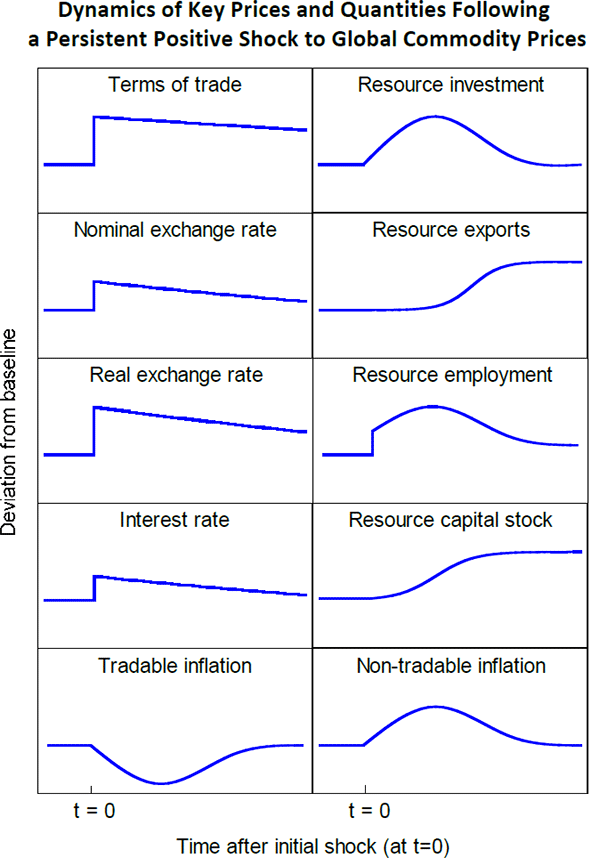
In reality, there are a number of reasons why an economy might not adjust in accordance with the theory outlined above; for example, households, firms and authorities do not have perfect knowledge of the timing and magnitude of the terms of trade boom at the outset, and it takes time for firms to adjust to changing circumstances. There are also many forces affecting the economy at a given point in time, making it difficult to isolate the impact of a single shock. Nonetheless, the theory provides a useful heuristic framework for analysing the response of the Australian economy to the terms of trade boom.
3. The Terms of Trade Boom and Structural Change in Australia
Developments in the Australian economy since the onset of the terms of trade boom have been broadly consistent with the stylised framework outlined in Section 2. In response to the large increase in commodity prices and the terms of trade, investment and employment in the resource sector have grown strongly, placing upward pressure on prices and wages. This has been offset to some extent by the appreciation of the exchange rate, which has led to a loss of competitiveness and downward pressure on prices in other industries, particularly those exposed to foreign trade.
This section examines these developments in more detail, by considering the three (overlapping) phases of the boom. To be clear, these are:
- Phase I: The rapid increase in commodity prices, and hence the terms of trade, and the appreciation of the exchange rate;
- Phase II: The mining investment boom; and
- Phase III: The mining production and export phase.
We look at how key variables in the resource, other tradable and non-tradable sectors have evolved over recent years, while also noting some important ways in which developments in the Australian economy are not well represented by the theoretical framework presented in Section 2.
In what follows, the ‘resource sector’ is defined broadly to include both resource extraction and resource-related activity:
- Resource extraction includes mineral and gas extraction, and also resource-specific manufacturing (such as the production of metals and refined petroleum). Hereafter, resource extraction is sometimes referred to loosely as mining.
- Resource-related activity includes resource investment that supports future production of resources and the provision of intermediate inputs in support of the current production of resources. In other words, it captures activities that are directly connected to resource extraction, such as constructing mines and associated infrastructure, and transporting inputs to, and taking extracted resources away from, mines. It also captures some activities less obviously connected to resource extraction, such as engineering and other professional services (legal and accounting work, for example).[5]
Non-resource activity includes everything else in the economy that does not have a direct relationship to the production of resources. Non-resource activity can be broken down further, at least conceptually, into tradable and non-tradable activity. The literature proposes several methods for creating this division in practice (see Dwyer and Groeger (1994) for a review). For simplicity, this paper uses the agriculture, manufacturing and tourism (that is, transport and accommodation & food services) industries as a proxy for the non-resource tradable sector.[6] This ‘rule-of-thumb’ allocation is consistent with a ‘threshold’ approach, in which industries are allocated to the tradable sector if either their exports or competing imports are greater than a certain share of their gross output (generally 10 per cent; see Table B1 in Appendix B).[7] The remaining non-tradable, non-resource industries comprise the various utilities and services.
The key prices and quantities of interest are shown in Table 1, which compares the inflation-targeting period prior to 2003/04 with the period of the rapidly rising terms of trade thereafter.
| Pre terms of trade boom (1992/93 – 2002/03) |
Terms of trade boom (2003/04 – 2011/12)1 |
|
|---|---|---|
| Terms of trade | ½ | 7¼ |
| Nominal TWI | −¾ | 4 |
| Real TWI | −1 | 5¼ |
| Borrowing rates (housing)2 | 8 | 7 |
| Borrowing rates (business)2 | 8¼ | 7¼ |
| Consumer price index3 | 2½ | 2¾ |
| Tradable | 2 | 1½ |
| Non-tradable | 2¾ | 4 |
| Wage price index4 | 3¼ | 3¾ |
| Resource/mining | 3 | 4¾ |
| Other tradable | 3 | 3½ |
| Non-tradable | 3¼ | 3¾ |
| Real investment | 6¼ | 6¼ |
| Resource/mining | 5¼ | 22¼ |
| Other tradable | 5¼ | 3½ |
| Non-tradable | 7 | 5 |
| Employment (heads) | 2 | 2¼ |
| Resource | ½ | 11¼ |
| Other tradable | ¼ | −1¼ |
| Non-tradable | 2½ | 2¼ |
| Real output | 3¾ | 3 |
| Resource | 3½ | 6¾ |
| Other tradable | 2½ | ¾ |
| Non-tradable | 4½ | 3 |
| Real exports | 6 | 3 |
| Resource | 5½ | 3½ |
| Other | 6¼ | 2 |
|
1 Sectoral investment and output data for 2011/12 are RBA estimates. Sources: ABS; APRA; RBA; Perpetual |
||
3.1 Phase I: The Rise in Commodity Prices, the Terms of Trade and the Exchange Rate
The rapid urbanisation and industrialisation of emerging economies in Asia – particularly China – has led to a dramatic increase in the global demand for commodities used in steel and energy production. With global supply responding only gradually to the surge in demand, this has led to sharp increases in the prices of commodities of which Australia has significant endowments. Consequently, Australia has experienced a rapid increase in its terms of trade, by 85 per cent from 2003/04 to September 2011, to their highest level on record; they have subsequently declined by around 9 per cent.[8]
This run-up in the terms of trade has provided a significant boost to the real purchasing power of domestic production. For example, Stevens (2010) noted that, prior to the terms of trade boom, a ship load of iron ore was worth about 2,200 flat screen television sets. In 2010 it was worth about 22,000 flat screen television sets. This is akin to saying that Australians have received a transfer of income from the rest of the world. A simple estimate that compares real GDP to a measure of production that adjusts for changes in purchasing power due to the terms of trade, suggests that Australians could be up to 10–15 per cent ‘better off’, in terms of their command over global production, as a direct result of the higher terms of trade. However, the benefit accruing to Australian residents will be less than this, to the extent that part of the resource sector is foreign owned.[9]
The distribution of these real income gains across the economy depends, crucially, on how much the exchange rate appreciates in response to the positive shock to world commodity prices (RBA 2005). An appreciation of the exchange rate means that: the increase in the domestic currency price of commodity exports will be less than the increase in world commodity prices; the income of the other tradable sector will fall; and real income gains flow to the broader economy via the associated decline in the price of imports. This is the key mechanism by which households, and other buyers of imported products, have benefited from the first phase of the resource boom.
The exchange rate has played a particularly important role in smoothing the effects of terms of trade shocks in Australia over this phase of the boom.[10] Since the terms of trade started to rise in 2003/04, the nominal exchange rate has appreciated by around 25 per cent in trade-weighted terms. Thus, as described in Blundell-Wignall and Gregory (1990), most of the real exchange rate appreciation necessary to maintain internal balance following the terms of trade shock has been achieved by an appreciation of the nominal exchange rate. This has not been the case in much earlier terms of trade booms in Australia, during which the exchange rate was either fixed or heavily managed, when much of the adjustment to the real exchange rate was achieved via higher inflation (see Appendix A).
However, the nature of the increase in commodity prices and the terms of trade, and the exchange rate appreciation, demonstrates a clear distinction between the theory presented in Section 2 and the reality of the current boom. In particular, the large rise in the terms of trade occurred over a number of years, rather than a once-off jump, and the extent of the rise was largely unexpected. This reflects the fact that the pace of development in emerging Asia consistently exceeded expectations (Figure 4). As a result, analysts (including official forecasters) under-predicted the extent of the increase in commodity prices, and therefore the terms of trade, and the associated exchange rate appreciation, which also occurred over a number of years.
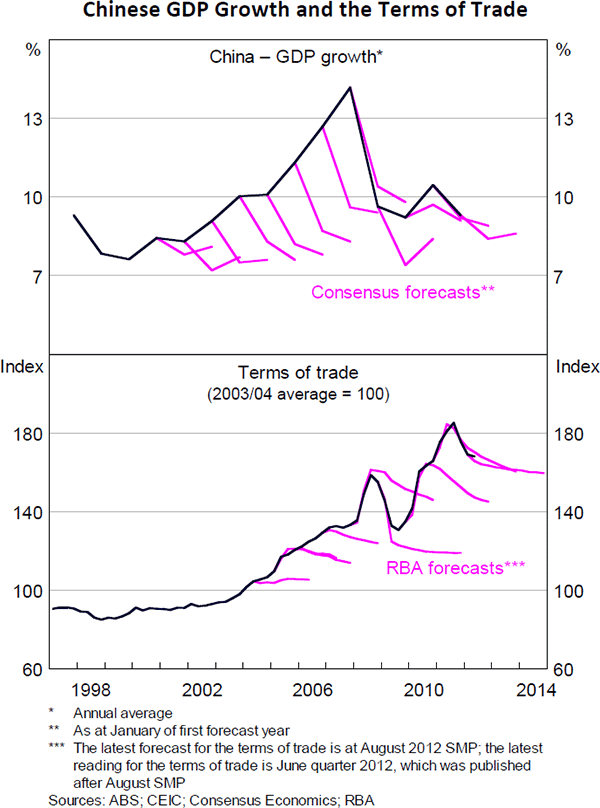
3.2 Phase II: The Mining Investment Boom
3.2.1 Investment
The resource sector globally has responded to the large rise in commodity prices by expanding its productive capacity. This has occurred gradually over a number of years, reflecting the unforeseen magnitude of the increase in commodity prices and the time frame required to plan for, approve and then complete large investment projects. In Australia, over recent years, the growth in investment in the extraction of iron ore, coal and liquefied natural gas (LNG) has been exceptionally strong (Figure 5). Indeed, the net capital stock of the resource sector has more than doubled since 2004, and is expected to continue to grow rapidly over the next few years, particularly in the LNG sector. At the time of the Bank's August 2012 Statement on Monetary Policy (SMP), the central forecasts for growth embodied the expectation that investment in the resource sector would peak at around 9 per cent of GDP in 2013/14, compared to its average of 2 per cent of GDP over the past half century.[11]
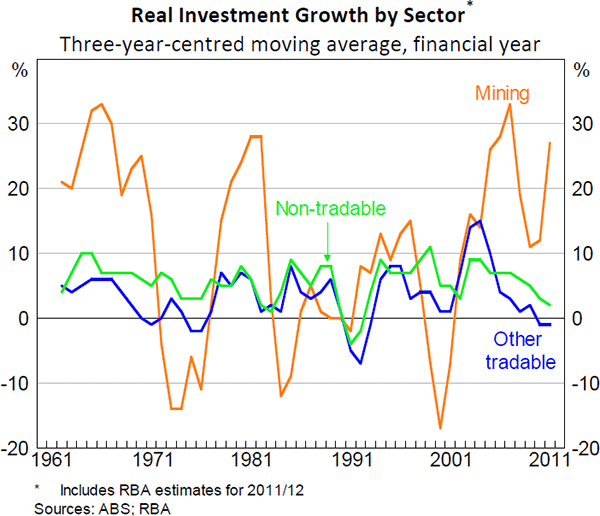
The effect of this investment on GDP is reduced to the extent that a significant share of the investment is imported. It appears that around half of the value of these resource investment projects is imported – with the remaining half being sourced domestically – although this varies somewhat depending on the nature of the project. LNG projects, for example, typically involve higher shares of imported capital inputs. (The estimates of resource output presented in this paper have adjusted the value of mining investment for its estimated import content.)
The high level of the exchange rate appears to have had a dampening effect on investment in the rest of the tradable sector. The average growth rate of real investment in the ‘other’ tradable sector was lower over the period since the terms of trade moved higher (Table 1 and Figure 5). More recently, real investment actually declined in this sector. Similarly, non-tradable capacity has expanded at a slower rate over this period, although this may reflect other forces acting on demand in this sector (see below).
3.2.2 The impact of the mining investment boom on output in other sectors
As the mining investment boom has gathered pace, the output of the broader resource-related sector, as measured by its total gross value added, has risen strongly (Figure 6 and Figure 7). This is particularly true for the resource-related construction and business services industries, which supply a large quantity of inputs required for resource investment (and resource extraction). Note, however, that there has not yet been a commensurate pick-up in resource extraction, although this is expected in coming years as the large projects come on line (see Section 3.3.1).

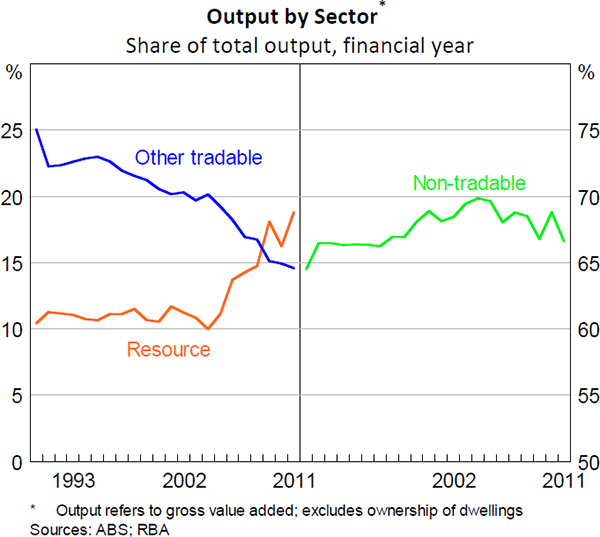
To sustain the growth in the resource-related sector, factors of production have been directed away from the other tradable and non-tradable sectors, and output growth in those sectors has slowed. In the case of the other tradable sector, total production has grown quite slowly and even declined in some years. Weakness has been notable in parts of manufacturing not exposed to the resource sector, such as textiles, clothing & footwear and wood & paper manufacturing. Output of the non-tradable sector has also slowed, but by less than the other tradable sector, given that it is not as exposed to currency movements and has benefited from ‘income effects’ from the higher terms of trade. This slowing in non-tradable output has been broadly based across industries, though some sectors, such as health services, have performed strongly.
It should also be noted that there have been other factors, outside of Asian development and the associated large increase in commodity prices and the exchange rate, that have had an effect on economic activity in Australia. The global financial crisis caused significant disruption to financial markets and economic activity, albeit to a much lesser extent in Australia than in the north Atlantic economies. There has subsequently been an increase in the rate of household saving and slower credit growth, and the transition to more stable levels of indebtedness and house prices (relative to incomes) has continued. In addition to its direct impact on financial sector output, this has contributed to weakness in non-mining construction and property turnover, as well as slower growth of retail spending (Lowe 2012 and Stevens 2012). Furthermore, there has been a relatively broad-based slowing in Australia's productivity growth since the early 2000s; some, but certainly not all of this can be explained by developments in the resource sector (D'Arcy and Gustafsson 2012).
3.2.3 Employment
Aggregate employment has grown at an above-trend pace since the onset of the terms of trade boom. Over this period, the composition of employment growth has changed significantly (Figure 8 and Figure 9). The share of total employment accounted for by the resource sector (including both extraction and resource-related activity) has doubled since the mid 2000s, to be around 10 per cent.[12] A substantial part of this growth reflects the expansion in resource investment, which has increased demand for labour in resource-related construction and other industries that provide inputs to these investment projects (such as types of machinery manufacturing and engineering services). The share of workers employed in the resource extraction industry – in other words, the ABS definition of ‘mining’ – has accounted for only about one-fifth of the overall increase in the resource sector's share of employment since 2004. Once the peak in mining investment spending has passed, and the resource boom enters its production phase, the share of labour employed in the more labor-intensive resource-related sector is likely to decline and the share employed in less labor-intensive resource extraction sector is likely to rise. The net effect though will be a decline in labour demand in the resource economy in the production phase. Based on the Bank's industry liaison, the ratio of workers required in the ‘mining investment’ phase relative to the ‘mining production’ phase is estimated to be around 4:1 in the case of iron ore, and substantially higher than this in the case of LNG (around 15–20:1).

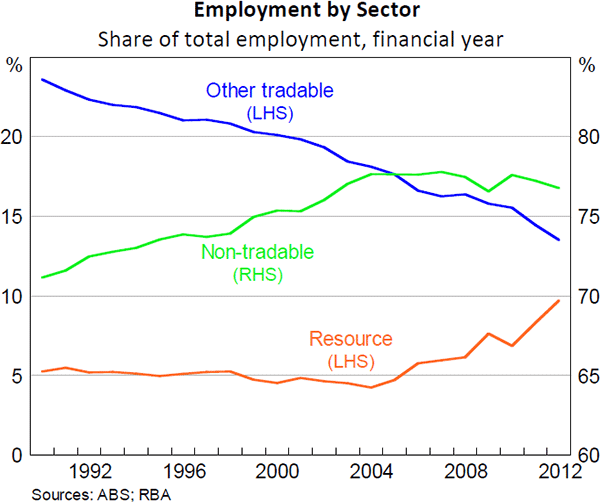
In contrast to the strong employment growth in the resource sector, employment growth has slowed significantly in the non-tradable sector (particularly in retail and the parts of construction not exposed to the resource sector) and has contracted in the other tradable sector (Figure 9). This is consistent with labour moving from the non-resource sector to the resource sector in response to the higher relative wages on offer in the latter (see below), but could also reflect other factors such as the rise in the household saving rate and weakness in the housing sector.
It is worth noting, however, that the recent decline in the other tradable sector's share of total employment is a continuation of a longer-run structural shift since the 1960s. As real incomes have risen, consumer demand has shifted increasingly toward services, and this, combined with deregulation and privatisation of a range of services industries and the reduction in the level of trade protection provided to goods-producing industries has seen the tradable sector decline as a share of employment, and the non-tradable (service) sector rise.[13]
The share of labour resources employed in the non-tradable sector has plateaued since around 2004, and is in line with the relatively stable share of non-tradable goods and services in production. This is consistent with the ‘income effect’ of the higher terms of trade having broadly offset the ‘substitution effect’ induced by the higher relative price of non-tradable goods (see section 3.2.5). However, as noted above, other developments largely unrelated to the high level of the terms of trade and the exchange rate are likely to have played a role in the stabilisation of the share of employment and output in the non-tradable sector. Most obvious is the weakness in the housing market; as a share of nominal GDP, dwelling investment peaked in 2003 at about 6½ per cent and has trended down to be a little under 5 per cent in early 2012.
3.2.4 Wages
The pace of aggregate wage growth picked up from 2003 until 2008. In the period immediately prior to the global financial crisis, the unemployment rate in Australia had fallen to its lowest level in more than three decades and there was considerable pressure on capacity in the economy. This resulted in a pick-up in both wage and price inflation. When the slowdown associated with the global financial crisis occurred, these pressures on capacity eased and there was a significant moderation in wage growth. Aggregate wage pressures have since firmed, particularly in the private sector, although wage growth remains below its immediate pre-crisis levels (Figure 10).
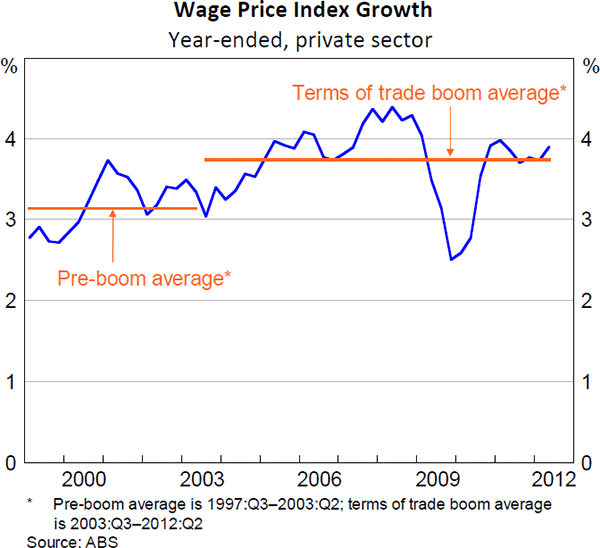
In terms of wage relativities, wages have risen more rapidly in the mining sector than in the rest of the economy since the beginning of the resource boom, with much of this adjustment occurring between 2005 and 2009 (Figure 11). As a result, the relative wage in mining – that is, resource extraction – has risen by about 10 per cent (by far the largest increase of any single industry), after having trended lower over the decade leading up to the boom (Figure 12). It also appears that relative wages have risen in sectors complementary to resource extraction, principally mining construction, mining services and mining-related manufacturing.[14]
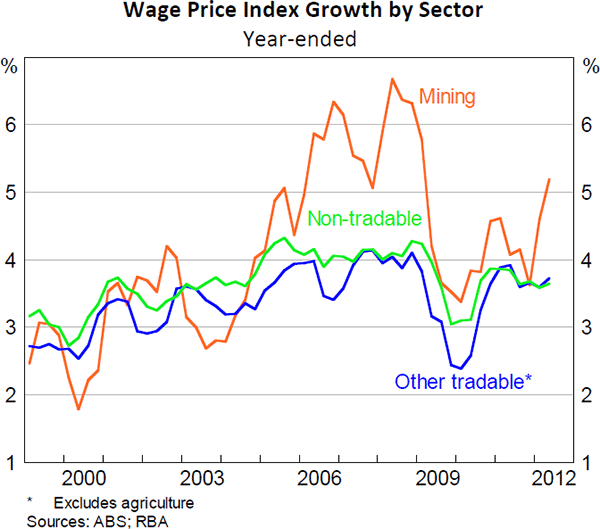

There has been very little movement in the relative wage in the non-tradable sector overall and a decline in the other tradable sector. This has been a key mechanism facilitating the sectoral reallocation of labour: the sectors benefiting from output price increases – which can afford to pay the higher wage rate – draw labour away from other sectors.
It is important to note, however, that even though the adjustment to the absolute level of wages overall has been smaller than in previous terms of trade booms, such as the early 1970s energy boom (Figure 13), the adjustment in relative wages over the most recent boom has been substantial. This change in relative wages and the relatively modest adjustment in overall wages have been helped by the combination of well-anchored inflation expectations and a more flexible labour market, particularly in comparison to earlier terms of trade booms. During these earlier booms, inflation had been more variable and Australia's centralised wage-setting system had the effect of spreading wage increases across the economy, to occupational categories for which the value of marginal product had not increased. Not surprisingly then, the result was a rise in inflation and unemployment (Gruen 2006, Battellino 2010 and Banks 2011). It is also important to note that at the beginning of the current boom, the unemployment rate was around 6 per cent, suggesting that there was some excess capacity in the labour market at the outset of the adjustment to the mining investment boom (this is another point of departure from the theory presented in Section 2, which assumes that the economy is in equilibrium prior to the boom). The need for relative wages to adjust may also have been lessened by adjustment in participation rates across different regions and the utilisation of skilled labour brought from offshore by the resource sector (for example, via 457 visas).

Another aspect to flexibility is the geographic mobility of labour within Australia. Interstate migration has played a limited role in the adjustment to the resource boom so far. For example, Western Australia has recorded modest net inflows of residents from other states, which has added around 35,000 to its population in cumulative terms since the onset of the terms of trade boom. If a similar proportion of interstate migrants are employed as existing residents, then these interstate flows would have contributed less than one-tenth to total employment growth in Western Australia on average since the start of the resource boom, compared with a contribution of around one-half from net overseas migration.[15]
To supplement these more permanent population shifts, many resource firms have been employing workers on a ‘fly-in-fly-out’ (FIFO) basis. Recently released data from the 2011 Census suggest that mining-focused areas such as the Pilbara in Western Australia and the Bowen Basin in Queensland have a much higher proportion of FIFO workers, and a much smaller share of permanent residents, than other townships (and capital cities) in Australia.[16] The data suggest a little more than 30 per cent of all people in these ‘mining areas’ on Census night were FIFO workers, compared with about 15 per cent in 2006, and 4–5 per cent in other towns. Once the mining investment phase comes to an end, the utilisation of FIFO labour is likely to fall as labour demand in these areas declines. To the extent that much of the extra demand for labour in remote locations is temporary, an advantage of FIFO arrangements is that they can help limit the extent of housing and infrastructure required to service the workforce, and therefore reduce the extent of unused capacity when the boom ultimately passes.
3.2.5 Prices
Consumer price inflation has averaged around 2¾ per cent since the mid 2000s (Figure 14). This was higher than the average inflation rate in the preceding decade, of 2½ per cent, but within the official inflation target of 2–3 per cent on average over the economic cycle. This has been a remarkable outcome, given the sheer magnitude of the shock to the terms of trade (and hence, incomes), and also relative to the higher inflation outcomes of previous terms of trade booms in Australia.
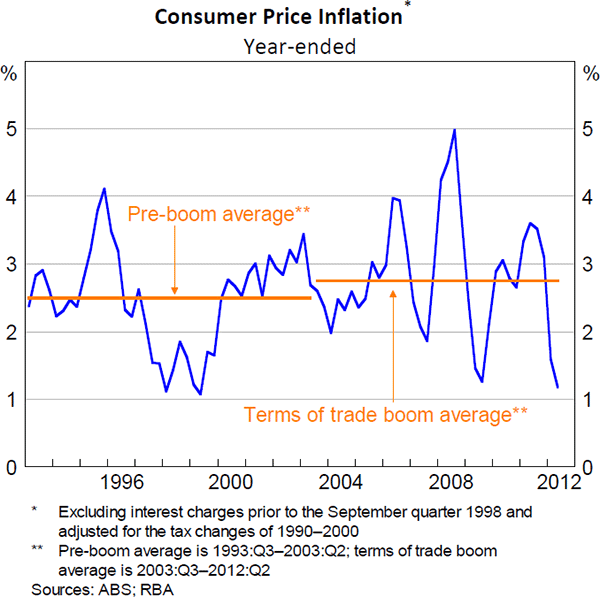
There have, however, been large shifts in relative consumer prices. Non-tradables inflation has been stronger throughout the period of the terms of trade boom, as higher domestic cost pressures have fed through to prices. Other factors less directly related to the mining investment boom have also contributed to higher non-tradables inflation in recent years. For example, utilities price inflation picked up significantly from 2007, reflecting the move towards cost-based pricing, the replacement and expansion of infrastructure to meet demand, and rising input costs (Plumb and Davis 2010). Productivity growth has also slowed since the early 2000s.
At the same time, the higher exchange rate contributed to a noticeable decline in tradables inflation. These developments imply that the ratio of non-tradable to tradable prices rose much more rapidly after 2003 compared to the trend of the previous two decades (Figure 15).[17] This earlier underlying trend reflects the Balassa-Samuelson effect (that is, productivity tends to rise more rapidly in the tradable sector than the non-tradable sector, so even though wages will tend to be equalised across sectors over the longer run, unit labour costs will rise more rapidly in the non-tradable sector).[18] The fact that the ratio of non-tradable prices to tradable prices has risen faster than this earlier trend is consistent with the theory outlined in Section 2.
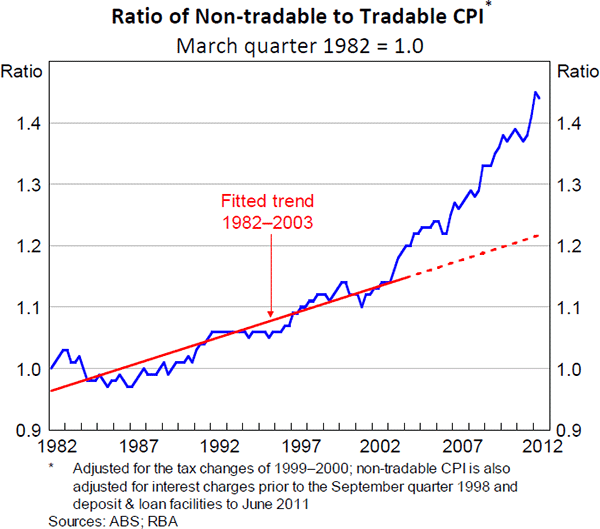
3.2.6 Interest rates
Interest rates rose over the first part of the mining boom, from a bit below to a bit above their average over the post-1996 period (Figure 16). In part this increase was due to an increase in the cash rate in light of inflationary pressures building on the back of the boom in the resource sector, as well as reflecting the increasing return to capital in Australia at that time; thereafter, interest rates declined sharply in response to the global financial crisis. There has been considerably less adjustment of interest rates in the current episode, however, relative to earlier commodity price booms; for example, the energy boom in the late 1970s/early 1980s, which was smaller than the current resource boom. One reason is that the flexible exchange rate provides a considerable buffer against external shocks, such that less adjustment of interest rates is required to manage domestic monetary conditions. In other words, the flexible exchange rate has contributed to less volatility in interest rates (Figure 17 and Figure 18; Debelle and Plumb 2006).

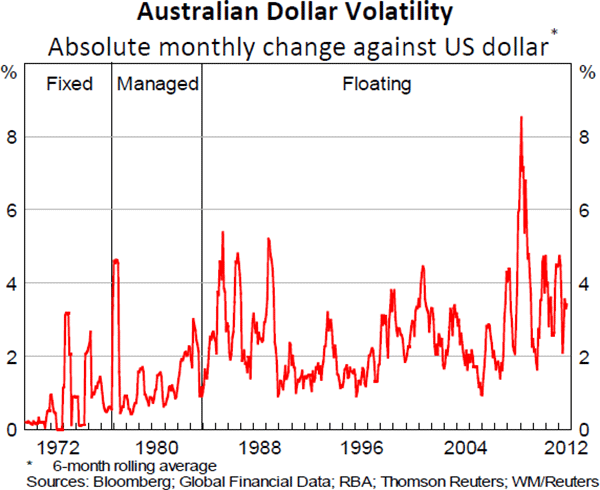
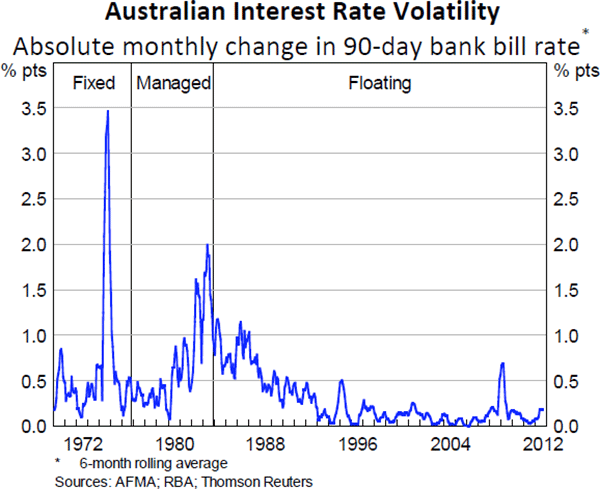
3.3 Phase III: Mining Production and Exports
3.3.1 Mining production and exports
The response of resource production and exports to an increase in prices is typically delayed, reflecting the time needed to plan, gain approval for, and reallocate scarce productive inputs to enable construction of new infrastructure.[19] For some commodities, there has already been a significant pick-up in output and exports. Since the onset of the terms of trade boom, the volume of iron ore extracted and exported has risen at an annual rate of 11¼ per cent, reflecting both capacity expansion and increased utilisation of existing capacity (Figure 19). LNG production has also risen strongly. Coal production has expanded, but at a broadly similar pace to its pre-boom average, reflecting a sluggish recovery in coal production from the floods in early 2011 and ongoing infrastructure bottlenecks and congestion along the coal production chain.

Given the significant expansions in capacity in the resource sector over recent years, and the lag between investment and the corresponding output, the production phase of the resource boom is expected to gather momentum over the next couple of years.[20] In its projections published in July 2012, the Bureau of Resources and Energy Economics anticipated strong growth in iron ore and coal exports over the next half decade, of around 9–10 per cent per year (Figure 19).[21] Growth in exports of LNG is expected to be even stronger, and this could see Australia emerge as the second largest global supplier of LNG in coming years (Jacobs 2011). Of course, with the terms of trade forecast to trend lower over time, it is likely that the growth in the value of these exports will be less than the growth in the volumes.
The strong growth in production and exports of these commodities over recent years has been offset, to a large extent, by weaker performance in other resource commodities. Most notably, oil production peaked in 2000, and since then has fallen by around 45 per cent as a result of the exhaustion of several of Australia's major oil basins. The extraction of other ores – such as bauxite, copper, gold, lead, nickel and zinc – has also declined in volumes terms over the past decade as has the export volume of processed metals (Connolly and Orsmond 2011).
Reflecting these offsetting developments, the volume of Australia's total resource exports has risen at an annual rate of 3 ½ per cent over the course of the terms of trade boom (Table 1; Figure 20). This is a notable slowing from its 1993–2003 average of 5½ per cent, notwithstanding a more than doubling of the capital stock and employment in the resource extraction sector. However, the volume of Australia's resource exports is expected to increase at a faster pace in coming years.
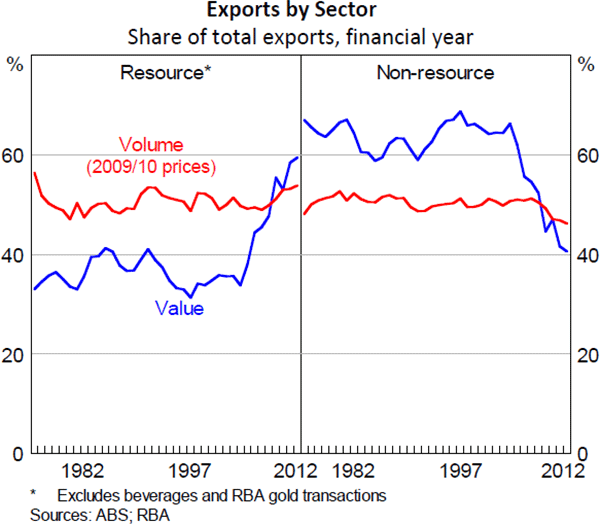
3.3.2 Non-resource exports
The high level of the exchange rate and the impact of the global financial crisis on external demand have weighed on exports of non-resource goods and services. Exports of manufactured products from Australia remain well below their 2008 peak, even though the volume of global trade has surpassed its 2008 level (Figure 21). In particular, some of Australia's more traditional manufacturing export sectors, such as construction materials and road vehicles, are well down on their earlier levels. That said, there has been growth in some categories of manufactured exports, including specialised industrial machinery and professional and scientific instruments (Lowe 2012).
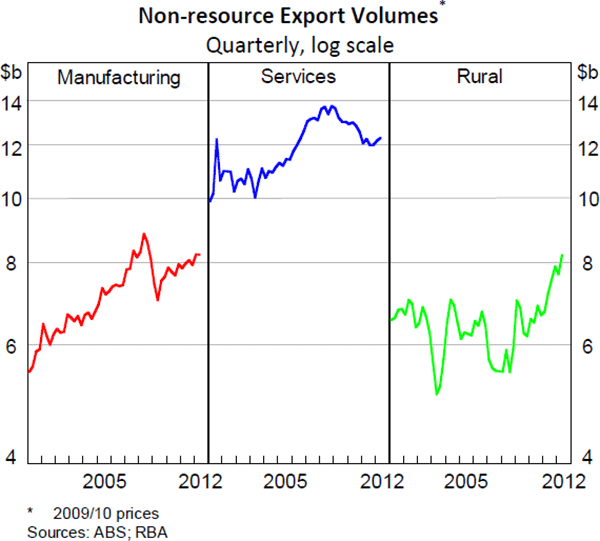
Exports of services have also declined significantly over the past 3–4 years – reflecting the ongoing high level of the exchange rate and the tightening of conditions for obtaining student visas – though there are tentative signs that the volume of service exports has stabilised recently. In contrast to the softness in manufactured and services exports over recent years, rural exports have grown strongly, helped by improved rainfall and relatively high prices for many rural commodities.
The relatively strong growth in Asia is clearly evident in the shares of Australian exports by destination. In 2011, Asian economies (excluding Japan) accounted for half of Australia's rural exports, compared to around one-third in 2000, and over 30 per cent of manufactured exports (Figure 22).[22] The share of Australia's services exports to non-Japan Asia has also increased, underpinned by strong growth in exports of education services. Also, short-term arrivals from China have been increasing rapidly – by around 13 per cent per annum over the past five years to be the second most important source of short-term arrivals (after New Zealand).
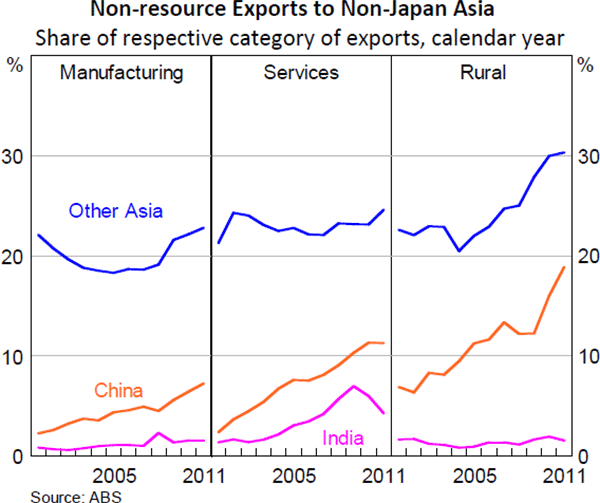
3.4 Beyond the Resource Investment Boom
At this stage the economy is only part of the way through the current mining boom. The phase of rapidly increasing commodity prices has, by all indications, now passed. The economy is still in the midst of the boom in resource investment, and although this investment is still expected to rise from here, prospects are that it will peak sometime in the next year or so. So it is important to consider how the broader economy might evolve as the resource sector transitions from the investment phase to the production phase of the boom.
The stylised framework of Section 2 can help us think about the evolution of the economy as the mining boom moves through the investment phase to the production phase. An efficient, forward-looking exchange rate market should already have factored in the expected decline in commodity prices associated with the gradual increase in global supply. As Section 2 suggested, in theory, some expected exchange rate depreciation may reflect any interest rate differential along the adjustment path following the initial positive shock to the terms of trade. However, changes in the terms of trade are difficult to anticipate with certainty. To the extent commodity prices and the terms of trade decline by more than anticipated, this would be expected to lead to a depreciation of the exchange rate as the demand for capital and imported inputs recedes. Even if this were not the case, with the mining production phase less labour intensive than mining investment, this should free up some labour in the resource sector to move back into the other tradable and non-tradable sectors, and be accompanied by a reduction in wages in the resource sector, at least relative to other sectors. This could lead to a reduction in domestically sourced cost pressures, although these will be offset to some extent by greater imported cost pressures arising from any exchange rate depreciation. While the reduction in demand for labour and capital in the resource sector frees up resources for the other tradable and non-tradable sectors, any depreciation of the exchange rate will also provide stimulus to the other tradable sector by improving its international competitiveness.
In terms of how this translates to recent and expected developments in the Australian economy, we have already witnessed a decline in the terms of trade, which up to June 2012 had decreased by around 9 per cent from the peak in September 2011. Subsequent sharp falls in the spot prices for iron ore and coking coal, to the extent that they are sustained, would lead the terms of trade to fall further than had earlier been expected.
Looking ahead, current forecasts suggest that the terms of trade will remain high in comparison to pre-boom levels. While it is impossible to be precise about the magnitude or the timing of near-term movements in commodity prices, this assumption seems reasonable on the grounds that industrialisation and urbanisation in China still has some way to run. For example, some estimates suggest that Chinese demand for steel used in residential construction will not peak until 2024 (Berkelmans and Wang 2012) – and countries such as India, Indonesia and Vietnam continue to develop. From Australia's perspective, there has been a large positive global demand shock in the resource sector over recent years that is likely to persist over the medium term.
However, while the terms of trade have declined from their peak in late 2011, the Australian dollar remains at a high level by historical standards, with the nominal trade-weighted index only a little below the multi-decade high recorded in early March 2012. One interpretation is that the recent decline in the terms of trade from their peak was anticipated and therefore already ‘priced in’ to the level of the exchange rate, but this ignores the unanticipated deterioration in the global economic outlook, fragile global financial sentiment and the speed of the decline in key commodity prices over this period. Ongoing strong foreign demand for Commonwealth Government Securities (CGS) is also likely to have been a factor supporting the Australian dollar. To the extent that the nominal exchange rate does not depreciate in line with unanticipated declines in commodity prices and the terms of trade, this will affect the adjustment in other sectors of the economy, particularly in the other tradable sector. Industries that have been most adversely affected by the high exchange rate, such as non-resource manufacturing, tourism and education, would also be the industries that would benefit most from any depreciation of the exchange rate.
If the resource investment profile described above is realised, then overall demand for labour in the resource sector may begin to ease at some point. So while employment and wage growth in the resource sector is presently robust, it is possible that this may start to reverse in the next couple of years. This suggests that some of the inflationary pressures in the non-tradable sector could moderate. Conversely, inflationary pressures in the tradable sector will be generated by any depreciation of the exchange rate, although it can take some time for currency movements to be reflected fully in the prices of imported consumer goods and services (Chung, Kohler and Lewis 2011).
Looking even further ahead, as Asian economies continue to develop and incomes rise, history suggests that demand will broaden beyond resources to other goods and services. For example, rising income per capita is typically associated with an increased share of consumption being directed towards services (Kuznets 1973). Given the population of developing Asia, the Asian market is large and is expected to get much larger still; by 2020, more than half the world's ‘middle class’ could be in Asia (Kharas 2010). From Australia's perspective, this could result in rising Asian demand for industries such as tourism, education, financial and other professional services, food and agribusiness, and specialised manufacturing, particularly related to agriculture and mining. As noted above, there is some evidence that this is already occurring.
Another important feature of emerging Asian economies that will have implications for Australia is the continued development and integration of Asian financial markets. While the economies of Asia are highly integrated into the global trading system for goods and services, this is less true of financial systems in general across Asia (Lowe 2009). For example, private gross cross-border capital flows as a share of GDP have typically been much smaller in emerging Asia compared to developed economies. Even though saving ratios have been higher than investment ratios in emerging Asia in recent years – particularly in China – these ‘excess savings’ have predominantly been channelled to the rest of the world by the public sector in the form of authorities such as central banks buying foreign assets. While investment in Australia from emerging Asian economies has grown in recent years, it still represents only a small share of total foreign investment in Australia. For example, Chinese investment in Australia has increased rapidly since the mid 2000s – driven by strong foreign direct investment, particularly in the Australian resource sector – but still represented only 1 per cent of total foreign investment in Australia at the end of 2011 (US investment in Australia was 27 per cent of the total).
4. Conclusion
Strong growth in Asia will continue to provide significant benefits for the Australian economy. Most notable so far has been the boom in the resource sector. This boom has three overlapping phases. The first has seen commodity prices and hence Australia's terms of trade rising significantly over a period of a number of years. This has been accompanied by a sizeable appreciation of the exchange rate. The phase of strongly rising commodity prices appears to have passed, with the terms of trade having peaked late last year, although they remain at a high level historically. The second phase of investment in the resource sector has been in progress for some years and still has some way to run, with resource investment expected to peak as a share of GDP sometime over the course of the next year or so. The third phase of increased production and export of resources has also commenced but has much further to run, especially in the case of LNG, for which investment takes place over a number of years before production comes on stream.
The pattern of structural adjustment to this positive shock to the terms of trade has, to date, proceeded broadly in line with that suggested by a simple theoretical model that distinguishes between three sectors: resource; other tradables; and non-tradables. In particular, relative wages and prices have adjusted in a way that has facilitated the reallocation of productive resources towards the resource sector. While not all parts of the economy have benefited equally, the process of structural adjustment has occurred relatively smoothly overall; output has grown at close to trend rates, unemployment has remained relatively low and inflation has been close to target. This stands in stark contrast to some earlier episodes of commodity price booms in Australia. One critical element to the adjustment this time around has been the timely appreciation of the exchange rate as the terms of trade consistently exceeded earlier expectations. The adjustment has also been helped by the anchoring of inflation expectations and the operation of the labour market, whereby wage pressures in industries or regions experiencing strong conditions associated with the boom in resource investment have not spilled over to parts of the economy experiencing weaker conditions.
Much of the employment growth in the resource sector over recent years has been driven by the relatively more labour intensive resource-related activities associated with resource investment. Once resource investment peaks, this suggests that demand for labour in the resource sector could decline and the contribution of resource investment to output growth will turn around. Part of this will be replaced by strong production and export of resources. The extent to which a pick-up in other activity requires a shift in relative prices, including through the exchange rate, remains to be seen.
Looking further ahead, there will come a time when the demand for commodities will ease as development of economies in the Asian region proceeds and the focus of consumption shifts away from goods and towards services. Such a transformation might appear to be disadvantageous for economies such as Australia that have hitherto been focused on supplying these economies with commodities. However, some Australian service industries, such as education, and parts of the rural sector have already experienced a significant increase in demand from Asia, notwithstanding the high level of the exchange rate. Rising demand for household, business and financial services more generally in this large part of the global economy is relatively advantageous for the Australian economy, in part because it is closer to this region than it is to most advanced economies, but also because of its well-developed and relatively open services sector.
Appendix A: Adjustment Under a Fixed Exchange Rate Regime
In a fixed exchange rate regime, the real exchange rate appreciation that is the key part of the adjustment to a rise in the terms of trade must occur via higher overall wage and, therefore, price inflation. With no change in the nominal exchange rate, wages need to rise to force labour to move away from the other tradable sector and into the resource and non-tradable sectors. Relative wages across sectors can still adjust though as per the flexible exchange rate regime case. Higher wages in the non-tradable sector imply higher non-tradable prices, with no offset to demand for non-tradable goods and services coming from lower tradable prices.
Interest rates are fixed to those prevailing in the rest of the world in the fixed exchange rate regime, if we assume that capital markets are closely integrated (although this was not true during the 1950s Korean War wool boom episode).
Following the peak in demand for labour during the course of the investment boom, the economy is left with a difficult adjustment because it takes time for the rise in wages to be unwound (assuming that wages are sticky downwards). This implies a period of unemployment to put downward pressure on wages in Australian dollar terms.
Australia's earlier experience of terms of trade booms under a fixed exchange rate regime broadly followed this story (Gruen 2006, Battellino 2010 and Banks 2011). Under the fixed exchange rate regime, the relationship between the terms of trade and the nominal exchange rate was nowhere near as close, although the trends over a long horizon were similar. The authorities tried to accommodate terms of trade shocks by occasional realignments of the exchange rate. But, invariably, these were too little and too late. Thus, the nominal exchange rate did not act as a sufficient buffer against the swings in the terms of trade. To illustrate, consider the terms of trade boom associated with the Korean War wool boom. The terms of trade almost tripled over the period 1943/44–1950/51, underpinned by an increase in the price of wool exports resulting from the Korean war (wool accounted for about half of export revenues in the late 1940s).[23] After peaking in 1950/51, wool prices fell sharply and continued to trend lower up until the early 1970s. In addition, mining and agriculture export prices both experienced a sharp increase and subsequent collapse, broadly in line with the wool price cycle.
This run-up in the prices of wool and other commodities provided a significant boost to national income, which in turn led to an expansion in aggregate demand. In a flexible exchange rate regime, the nominal exchange rate would generally be expected to appreciate in such an environment, but this was not the institutional framework in place at the time. Instead, the Australian dollar remained pegged to the British pound sterling, which had been devalued relative to the US dollar twice in the 1940s; by 14 per cent at the start of World War II and by 30 per cent in September 1949. Without the stabilising effect provided by a nominal exchange rate appreciation, the outcome was a marked pick-up in inflation, which peaked in 1950/51 in excess of 20 per cent; the highest annual rate of inflation recorded in the 20th century (Figure A1).[24]
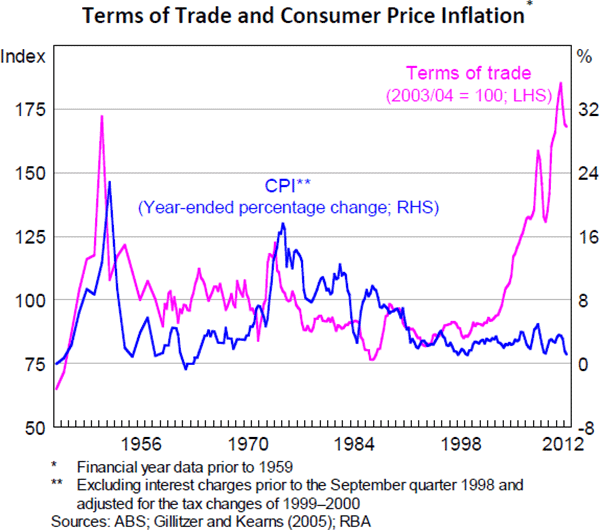
The labour market institutions in place in the 1940s and early 1950s, which were built around a federal ‘basic wage’ and the idea of comparative wage justice, contributed to this inflationary pressure. The federal minimum wage, which was indexed to inflation, was raised by 20 per cent in both 1950 and 1951. This system of wage setting not only muddied the price signals needed to reallocate resources across the economy, but also contributed to higher overall inflation via a ‘wage-price spiral’.[25]
With the nominal exchange rate unchanged, this pick-up in inflation meant that the adjustment to the higher terms of trade came about through real appreciation; on a real trade-weighted basis, the exchange rate appreciated by about 25 per cent between 1950 and 1953 (Figure 1). This reduced the competitiveness of the exporting and import competing sectors and facilitated the reallocation of factors of production. The high level of the real exchange rate persisted for around a decade after the collapse in the terms of trade. Some commentators have postulated that the real exchange rate may have been at a disequilibrium level over the 1950s, persistently overvalued because domestic costs were sticky downwards and the nominal exchange rate was fixed (McKenzie 1986).[26] This serves to highlight the important stabilising role that a flexible exchange rate can play during an upswing and a subsequent downswing in the terms of trade.
When the terms of trade fell by more than 35 per cent in 1951/52, the decline in incomes was associated with a slowing in real GDP growth in that year and a contraction in the economy in the year after. The unemployment rate also moved higher, albeit remaining at low levels overall. Nevertheless, the impact of the terms of trade collapse on economic growth appeared to be short-lived. The collapse of export prices and the associated contraction in output also resulted in a significant moderation in inflation (Figure A1).
How does this experience compare to the current episode? Inflation in consumer prices has remained within the official target, on average, and growth has remained not far from trend. Unemployment has remained generally low and stable, aside from the modest increase during global financial crisis. The key difference this time around is that the nominal exchange rate has been free to appreciate, and nominal wages free to adjust at different rates in different sectors of the economy. This is despite the current terms of trade boom being more persistent, having already lasted far longer than the Korean war episode, which implies the need for some comparatively larger structural adjustments to the economy.
Another key difference between the early 1950s terms of trade boom and current boom is the ownership structure of the resource sector (or, in the case of the 1950s boom, the agricultural sector). The proceeds from the Korean war boom accrued predominantly to Australian farmers. In contrast, a large share of the proceeds from the current terms of trade boom accrue to foreign-owned mining companies which, if they are not reinvested, are not likely to be spent on Australian goods and services.
Appendix B: Data
Table B1 presents the import penetration ratio and export propensity for each of the 19 ABS industry divisions in 2007/08.
| Import penetration1 |
Export propensity2 |
|
|---|---|---|
| Mining | 16½ | 50¾ |
| Other tradable sector | 24 | 19¼ |
| Agriculture, forestry & fishing | 2 | 13¼ |
| Manufacturing | 32½ | 22 |
| Accommodation & food services | 8¼ | 10½ |
| Transport, postal & warehousing | 9 | 18 |
| Non-tradable sector | 1½ | 2¼ |
| Electricity, gas, water and waste | 0 | ¼ |
| Construction | 0 | ¼ |
| Wholesale trade | 0 | 9 |
| Retail trade | 0 | 2¾ |
| Information, media & telecommunications | 8 | 2¾ |
| Finance & insurance | 1¼ | 1 |
| Rental, hiring & real estate | 1¾ | ¾ |
| Professional, scientific & technical | 3¼ | 4½ |
| Administrative & support services | 1½ | 1¾ |
| Public administration & safety | 0 | ¼ |
| Education & training | 2¾ | 8 |
| Health care & social assistance | ¾ | ½ |
| Arts & recreation services | 3 | 4 |
| Other services | ¼ | ¼ |
| Total | 10 | 10 |
|
1 Import penetration equals competing imports (indirectly allocated) as
a share of the total supply of the corresponding domestic industry. Sources: ABS; RBA |
||
Endnotes
This paper was prepared by James Bishop, Christopher Kent and Michael Plumb for the Structural Change and the Rise of Asia Conference, jointly hosted by the International Monetary Fund, the Australian Treasury and the Reserve Bank of Australia in Canberra. Views expressed in this paper are those of the authors and not necessarily those of the Reserve Bank. [*]
The purchasing power of the average wage is calculated by deflating average weekly earnings by the household final consumption deflator. [1]
See, for example, Berkelmans and Wang (2012). [2]
As Gregory (2011) has noted, the other purpose of these models was to increase understanding of the potential effects of two policy instruments that had not generally been used in Australia – a large across-the-board tariff cut and changes in the nominal exchange rate. [3]
The theory of uncovered interest parity (UIP), which connects expected changes in the exchange rate to interest differentials, is central to many international macroeconomic models. Yet empirically, UIP is consistently found not to hold (for a survey, see Engel 1996). [4]
Measuring resource extraction activity is relatively straightforward: it simply adds Australian Bureau of Statistics (ABS) data on the ‘mining’ industry to the relevant subdivisions of the ‘manufacturing’ industry. Measuring resource-related activity is more complex. The approach followed in this paper is to use the input-output tables produced by the ABS. These tables document the average share of inputs used by a given industry that come from every other industry (and equivalently the share of an industry's output that is used by every other industry). These tables make it possible to identify those industries that supply inputs into the resource sector (including for resource investment). A detailed description of this methodology, and its limitations, is provided in Rayner and Bishop (forthcoming). [5]
Agriculture, manufacturing and transport activity that has been attributed to the resource sector (as inputs into resource production and investment) is subtracted from the non-resource tradable sector. Similarly for non-tradables. Due to data limitations, accommodation & food services is included in the non-tradable sector for gross value added and employment. [6]
More precisely, an industry is classified as ‘tradable’ if at least 10 per cent of its total production is exported, or if at least 10 per cent of its total supply is made up of competing imports. [7]
This is up to the June quarter of 2012. Other things equal, subsequent declines in spot prices for iron ore and coking coal would, if sustained, see the terms of trade fall further over the next few quarters. [8]
This adjustment to real GDP for changes in the terms of trade is based on the published measure of real gross domestic income (real GDI). Due to the high share of foreign ownership of the mining sector, it may also be appropriate to adjust for the income flows that accrue to foreigners (such as by using real gross national income (real GNI) in place of real GDI). However, as noted by Gregory (2011), the ABS estimate of ‘real incomes payable and receivable from the rest of the world’ is not a suitable measure for these purposes. [9]
See Blundell-Wignall and Gregory (1990), Gruen and Wilkinson (1994) and Debelle and Plumb (2006) for a discussion of episodes following the floating of the Australian dollar in 1983. [10]
Since then, in the context of sharp declines in the spot prices for iron ore and coking coal, a number of mining companies have signalled their intention to delay final decisions regarding investment projects under consideration, or review projects for which they had earlier made commitments to proceed. It is beyond the scope of this paper to consider the implications of these developments for the forecasts of mining investment and production. Of course, this sort of uncertainty is relevant to the question of the role of the exchange rate in adjusting to terms of trade shocks. [11]
These estimates for employment assume that the productivity of a worker will be the same if they supply their labour to the resource or non-resource sectors of the economy (see Rayner and Bishop (forthcoming)). [12]
This structural trend is particularly evident for manufacturing, whose share of employment fell from one-quarter in the 1960s to less than one-tenth in 2011. [13]
Relative wages in construction and professional services have increased strongly since 2004. However, these data mask potentially stronger growth in mining construction and mining services and relatively weaker outcomes in construction and services not exposed to mining. This is consistent with the Bank's liaison. [14]
The aggregate rate of interstate migration in Australia – calculated as gross interstate flows scaled to the population – has also been in decline since the early 2000s. [15]
While the Census does not identify FIFO workers specifically, we have assumed that all ‘visitors’ to a given area on Census night aged 25–54 years are FIFO labour, as in most regions only about 5 per cent of the total counted on Census night are visitors. A ‘visitor’ is any person who indicates that they are a visitor from another area on their Census form. This methodology clearly overstates the number of such workers present on Census night, in both mining areas and elsewhere, but is likely to provide a reasonable indicator. Note that these ‘mining areas’ are not tourist areas, and are defined to include the following statistical areas: the Pilbara (in Western Australia), Bowen Basin North (in Queensland) and Isaac (in Queensland). We have excluded the Hunter Valley (in New South Wales), which has a similar visitor-to-population ratio to the broader population, and liaison contacts and other sources indicate there is minimal FIFO in this region. Note also that FIFO workers not at their place of work on Census night are not captured in this measure. [16]
The picture is similar if utility prices are excluded from the calculation. [17]
See Balassa (1964) and Samuelson (1964). [18]
Indeed, these delays are one reason why world prices had remained high. [19]
The Productivity Commission (2008) estimate that the average lag between the time of initial commencement of new mining projects and the time it takes output from those projects to approach normal capacity to be between two and three years. [20]
The BREE projections for 2012 and 2013 were updated on 18 September 2012, with minor downward revisions to these export volumes in 2012 and 2013. [21]
In this section, Asian economies include China, India, Hong Kong, Indonesia, Korea, Malaysia, the Philippines, Singapore, Taiwan, Thailand and Vietnam. [22]
The Korean war itself stretched between June 1950 and July 1953, but we include the run-up in the late 1940s in the phrase ‘Korean war episode’. [23]
Another factor contributing to inflation over this period was the gradual removal of the price controls that had been put into place during the Second World War. [24]
Automatic indexation of the basic wage was abandoned in 1953, and a system of national wage cases was substituted that took account, in some unspecified mix, of a range of economic and industrial relations factors. [25]
Another explanation for the high real exchange rate is a broad concurrent upsurge in foreign direct investment in import-competing manufacturing. The stringent import licensing measures introduced in 1952 and lasting until 1960 may have served to counter the effect of real exchange rate overvaluation on the trade account. [26]
References
Balassa B (1964), ‘The Purchasing Power Parity Doctrine: A Reappraisal’, Journal of Political Economy, 72, pp 584–596.
Banks G (2011), ‘Australia's Mining Boom: What's the Problem?’, Paper presented to the Melbourne Institute and The Australian Economic and Social Outlook Conference 2011 ‘Growth Challenge: Riding the Resources Boom to Lasting Prosperity’, Melbourne, 30 June–1 July.
Battellino R (2010), ‘Mining Booms and the Australian Economy’, RBA Bulletin, March, pp 63–69.
Berkelmans L and H Wang (2012), ‘Chinese Urban Residential Construction to 2040’, RBA Research Discussion Paper No 2012-04.
Blundell-Wignall A and R Gregory (1990), ‘Exchange Rate Policy in Advanced Commodity-Exporting Countries: The Case of Australia and New Zealand’, OECD Economics Department Working Papers No 83.
Chung E, M Kohler and C Lewis (2011), ‘The Exchange Rate and Consumer Prices’, RBA Bulletin, September, pp 9–16.
Connolly E and Orsmond D (2011), ‘The Mining Industry: From Bust to Boom’, RBA Research Discussion Paper No 2011-08.
Corden WM (1982), ‘Exchange Rate Policy and the Resources Boom’, Economic Record, 58(1), pp 18–31.
Corden WM (1984), ‘Booming Sector and Dutch Disease Economics: Survey and Consolidation’, Oxford Economic Papers, 36(3), pp 359–380.
Corden WM and JP Neary (1982), ‘Booming Sector and De-industrialisation in a Small Open Economy’, The Economic Journal, 92(368), pp 825–848.
D'Arcy P and L Gustafsson (2012), ‘Australia's Productivity Performance and Real Incomes’, RBA Bulletin, June, pp 23–36.
Debelle G and M Plumb (2006), ‘The Evolution of Exchange Rate Policy and Capital Controls in Australia’, Asian Economic Papers, MIT Press, 5(2), pp 7–29.
Dwyer J and C Groeger (1994), ‘Resource Flows to the Traded Goods Sector’, RBA Research Discussion Paper No 9401.
Engel C (1996), ‘The Forward Discount Anomaly and the Risk Premium: a Survey of Recent Evidence’, Journal of Empirical Finance, 3(2), pp 123–192.
Gillitzer C and J Kearns (2005), ‘Long-term Patterns in Australia's Terms of Trade’, RBA Research Discussion Paper No 2005-01.
Gregory RG (1976), ‘Some Implications of the Growth of the Mineral Sector’, The Australian Journal of Agricultural Economics, 20(2), pp 71–91.
Gregory R (2011), ‘Living Standards, Terms of Trade and Foreign Ownership: Reflections on the Australian Mining Boom’, The Australian National University Discussion Paper No 656.
Gruen D and J Wilkinson (1994), ‘Australia's Real Exchange Rate – Is it explained by the Terms of Trade or by Real Interest Differentials’, Economic Record, 70(209), pp 204–219.
Gruen D (2006), ‘A Tale of Two Terms-of-Trade Booms’, Address to Australian Industry Group's Economy 2006 Forum, Melbourne, 1 March.
Gruen D (2011), ‘The Resources Boom and Structural Change in the Australian Economy’, Address to the Committee for Economic Development of Australia Economic and Political Overview, Melbourne, 24 February.
Henry K (2006), ‘Implications of China's Re-emergence for the Fiscal and Economic Outlook’, Address to the Australian Business Economists, Sydney, 16 May.
Henry K (2008), ‘Revisiting the Policy Requirements of the Terms-of-Trade Boom’, Address to the Australian Business Economists, Sydney, 20 May.
Jacobs D (2011), ‘The Global Market for Liquefied Natural Gas’, RBA Bulletin, September, pp 17–28.
Kharas H (2010), ‘The Emerging Middle Class in Developing Countries’, OECD Development Centre W Working Paper No 285.
Kuznets S (1973), ‘Modern Economic Growth: Findings and Reflections’, The American Economic Review, 63(3), pp 247–258.
Lowe P (2009), ‘The Development and Resilience of Financial Systems in Asia’, Remarks at In the Zone Conference, University of Western Australia, 7 November.
Lowe P (2012), ‘The Changing Structure of the Australian Economy and Monetary Policy’, Address to the Australian Industry Group 12th Annual Economic Forum, Sydney, 7 March.
McKenzie I (1986), ‘Australia's Real Exchange Rate during the Twentieth Century’, The Economic Record, Supplement, pp 69–78.
Plumb M and K Davis (2010), ‘Developments in Utilities Prices’, RBA Bulletin, December, pp 9–18.
Productivity Commission (2008), ‘Productivity in the Mining Industry: Measurement and Interpretation’, Working Paper, December.
Rayner V and J Bishop (forthcoming), ‘Measuring the Resource Economy’, RBA Research Discussion Paper.
Reserve Bank of Australia (2005), ‘Commodity Prices and the Terms of Trade’, RBA Bulletin, April, pp 1–7.
Salter WEG (1959), ‘Internal and External Balance: The Role of Price and Expenditure Effects’, Economic Record, 35(71), August, pp 226–238.
Samuelson P (1964), ‘Theoretical Notes on Trade Problems’, Review of Economics and Statistics, 23, pp 1–60.
Stevens G (2010), ‘The Challenge of Prosperity’, Address to the Committee for Economic Development of Australia (CEDA) Annual Dinner, Melbourne, 29 November.
Stevens G (2012), ‘The Glass Half Full’, Address to the American Chamber of Commerce (SA) AMCHAM Internode Business Lunch, Adelaide, 8 June.
Swan TW (1960), ‘Economic Control in a Dependent Economy’, Economic Record, 36(73), March, pp 51–66.